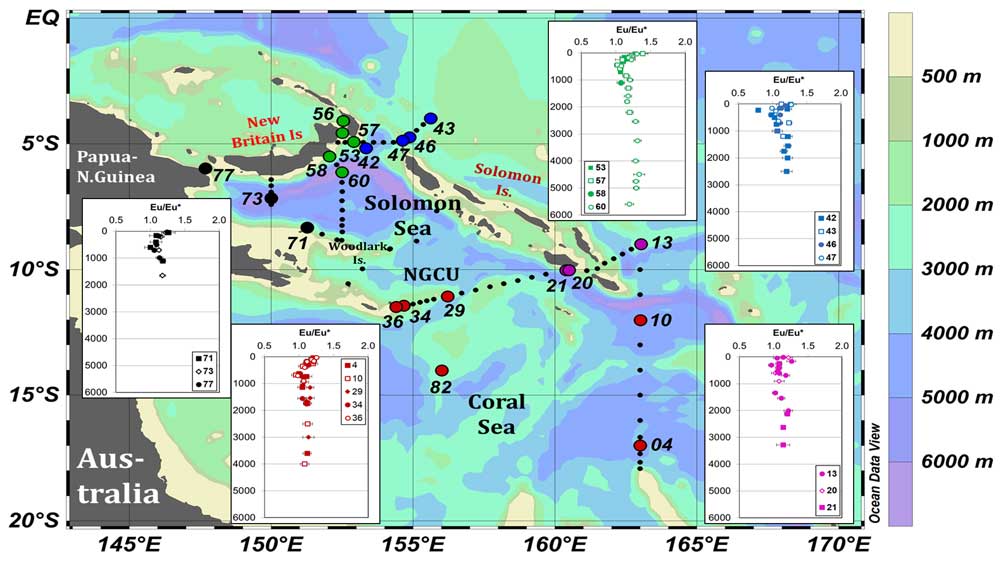Rare Earth distribution and pattern anomalies in the Solomon Sea
The Solomon Sea is surrounded by high and intensively weathered islands. Its complex topography and hydrography make this area a potential source of trace elements to the waters flowing through it. Dissolved rare earth elements (DREE) analysis of more than 150 samples collected in the framework of the PANDORA cruise (along GEOTRACES GP12 section) showed that DREE maxima reveal significant coastal effects at some locations, consistent with dissolved aluminum (Al) and manganese (Mn) data, enrichments mostly observed in the exiting Straits and along the island coasts. A box model allows calculating and discussing a net enrichment of the dissolved REE in the lower thermocline that further partially feeds the Equatorial Under Current cold tongue. Positive Europium (Eu) anomalies* allow identifying the basaltic nature of the lithogenic enrichments.

Figure: Vertical profiles of the anomalies of Eu (Eu/Eu*) after normalization to the PAAS values, calculated following Bau et al. (2004), Bau et al. (1996). The red circles correspond the Coral Sea and Southern entrance of the Solomon Sea. Samples collected in waters flowing through four straits (Indispensable, Vitiaz, St George’s and Solomon), are colored with dark violet, black, green and dark blue, respectively.
*Eu anomaly reflects the relative variation of the Eu abundance compared to its REE neighbors: it is calculated a the ratio between the measured Eu concentration and the interpolated one between these neighbors. In this paper, positive Eu anomalies (≥1) were found whatever water mass type and sample location. The higher dEu anomalies (~1.3) at the surface likely reflect recent enrichments of basaltic material origin from surrounding volcanic islands (Grenier et al., 2013).
Reference:
Pham, V. Q., Grenier, M., Cravatte, S., Michael, S., Jacquet, S., Belhadj, M., Nachez, Y., Germineaud, C., Jeandel, C. (2019). Dissolved rare earth elements distribution in the Solomon Sea. Chemical Geology, 524, 11–36. DOI: https://doi.org/10.1016/J.CHEMGEO.2019.05.012
Bau, M., Koschinsky, A., Dulski, P., Heinz, J.R. (1996) Comparison of the Partitioning Behaviours of Yttrium, Rare Earth Elements, and Titanium between Hydrogenetic Marine Ferromanganese Crusts and Seawate. Geochimica et Cosmochimica Acta, Volume 60, Issue 10, May 1996, Pages 1709-1725 DOI: https://doi.org/10.1016/0016-7037(96)00063-4
Bau, M., Alexander, B., Chesley, J.T., Dulski, P., Brantley, S.L. (2004). Mineral dissolution in the Cape Cod aquifer, Massachusetts, USA: I. Reaction stoichiometry and impact of accessory feldspar and glauconite on strontium isotopes, solute concentrations, and REY distribution. Geochim. Cosmochim. Acta, DOI: http://doi.org/10.1016/j.gca.2003.08.015
Grenier, M., Jeandel, J., Lacan, L., Vance, D., Venchiarutti, C., Cros, A., Cravatte, S. (2013) From the subtropics to the central equatorial Pacific Ocean: Neodymium isotopic composition and rare earth element concentration variations. Journal of Geophysical Research: Oceans DOI: http://doi.org/10.1029/2012JC008239
